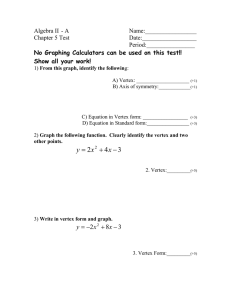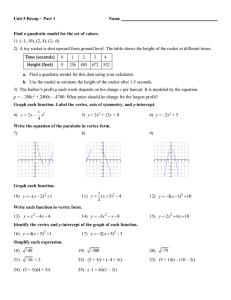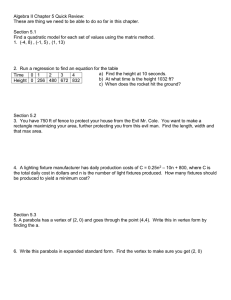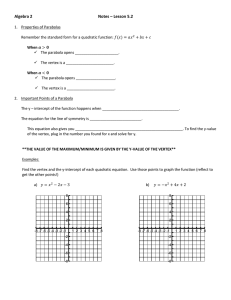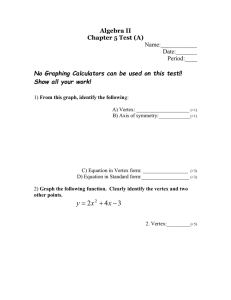On vertex operator realizations of Jack functions Wuxing Cai · Naihuan Jing
advertisement
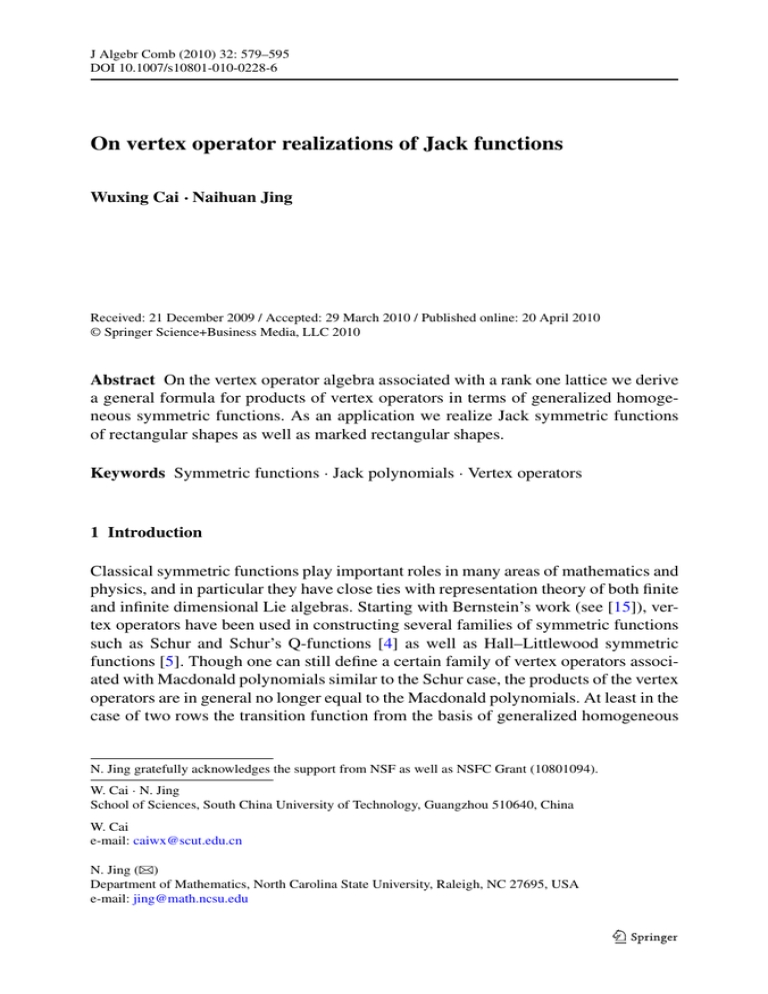
J Algebr Comb (2010) 32: 579–595
DOI 10.1007/s10801-010-0228-6
On vertex operator realizations of Jack functions
Wuxing Cai · Naihuan Jing
Received: 21 December 2009 / Accepted: 29 March 2010 / Published online: 20 April 2010
© Springer Science+Business Media, LLC 2010
Abstract On the vertex operator algebra associated with a rank one lattice we derive
a general formula for products of vertex operators in terms of generalized homogeneous symmetric functions. As an application we realize Jack symmetric functions
of rectangular shapes as well as marked rectangular shapes.
Keywords Symmetric functions · Jack polynomials · Vertex operators
1 Introduction
Classical symmetric functions play important roles in many areas of mathematics and
physics, and in particular they have close ties with representation theory of both finite
and infinite dimensional Lie algebras. Starting with Bernstein’s work (see [15]), vertex operators have been used in constructing several families of symmetric functions
such as Schur and Schur’s Q-functions [4] as well as Hall–Littlewood symmetric
functions [5]. Though one can still define a certain family of vertex operators associated with Macdonald polynomials similar to the Schur case, the products of the vertex
operators are in general no longer equal to the Macdonald polynomials. At least in the
case of two rows the transition function from the basis of generalized homogeneous
N. Jing gratefully acknowledges the support from NSF as well as NSFC Grant (10801094).
W. Cai · N. Jing
School of Sciences, South China University of Technology, Guangzhou 510640, China
W. Cai
e-mail: caiwx@scut.edu.cn
N. Jing ()
Department of Mathematics, North Carolina State University, Raleigh, NC 27695, USA
e-mail: jing@math.ncsu.edu
580
J Algebr Comb (2010) 32: 579–595
symmetric functions (product of one-row Mcdonald polynomials) involves with hypergeometric series of type 4 φ3 . Except for a few cases [6, 14], it has been an open
problem to find the transition function from the generalized homogeneous functions
to Macdonald symmetric functions [2, 6].
On the other hand, in the study of vertex representations of affine Lie algebras,
Lepowsky and Wilson [9] have long posted the important problem on whether certain products in the representation space are linearly independent. In the special case
of level three representations, this problem can be solved using Rogers–Ramanujan
identities (see also [8] for the homogeneous case). Later it was realized [6] that the
vertex operators at level three are actually related with vertex operators associated to
certain Jack polynomials, namely, the half vertex operators are actually the generating function of the one-row Jack functions. Thus it is also an interesting question to
study the linear independence problem for those vertex operators associated to Jack
functions.
Motivated by [1] we define the vertex operator associated with Jack functions in
the vertex operator algebra of rank one lattice. They are called Jack vertex operator since the product of identical modes of the vertex operator will be shown to be
Jack functions of rectangular shapes. It is interesting that
the contraction functions
for products of the new vertex operator are of the form i<j (zi − zj )2α instead of
α
−1 (which are for Y (z) in Sect. 3.2), as
1
i<j (zi − zj ) for the Jack parameter α
expected from experience with the Schur and Hall–Littlewood cases. It turns out that
one really needs this new form of vertex operators (vertex operator X(z) in Sect. 3.2)
to generate rectangular Jack functions. At the special case of Schur functions (α = 1),
our new vertex operators provide another formula for the rectangular shapes.
We also study the problem of linear independence for the new vertex operators in
the case of Jack functions. We show that under certain conditions the set of vertex
operator products is indeed a basis for the representation space (see [1] for a similar
statement). We achieve this by deriving a Jacobi–Trudi like formula for the Jack vertex operator, and then we reprove Mimachi–Yamada’s theorem [11] that the product
of the vertex operators are Jack functions for the rectangular shapes, and then we
further generalize this formula to the case of marked rectangular shapes, i.e., rectangular shapes minus part of the last column. This general case contains part of [7] as a
special case.
This paper is organized as follows. In Sect. 2 we recall some necessary notions of
symmetric functions. In Sect. 3 we first review the vertex operator approach based on
the second author’s work on Schur functions, then we define the Jack vertex operators
and give an explicit formula of the vertex operator products and a Jacobi–Trudi like
formula in terms of tableaux. In Sect. 4 we provide a detailed analysis of certain matrix coefficients of vertex operators and prove the theorem of realizing Jack functions
of rectangular and marked rectangular shapes.
2 Jack functions
We recall some basic notions about symmetric functions following the standard reference [10]. A partition λ is a sequence λ = (λ1 , λ2 , . . . , λs ) of nonnegative integer such that λ1 ≥ λ2 ≥ · · · ≥ λs ; the set of all partitions is denoted by P; we
J Algebr Comb (2010) 32: 579–595
581
sometimes write λ as (1m1 2m2 · · · ), where mi is the multiplicity of i occurring
in the parts of λ. The number of non-zero λi ’s is called the length of λ, denoted
by l(λ), and the weight |λ| is defined as λ1 + · · · + λs . A partition λ of weight n
is usually denoted by λ n. We also recall that the dominance order is defined by
comparing the partial sums of the parts. For two partitions λ and μ of the same
weight, if λ1 + · · · + λi ≥ μ1 + · · · + μi for all i, one says that λ is greater than
μ and denoted as λ ≥ μ; conventionally, λ > μ means λ ≥ μ but λ = μ. For
λ = (λ1 , λ2 , . . .) = (1m1 , 2m2 , . . .), μ = (μ1 , μ2 , . . .) = (1n1 , 2n2 , . . .) the notation
, . . . , and
λ − μ means (λ1 − μ1 , λ2 − μ2 , . . .), μ ⊂ λ means that n1 ≤ m1 , n2 ≤m2
m(λ)
1 m2
= m
λ\μ denotes the partition (1m1 −n1 2m2 −n2 · · · ). We also define m(μ)
n1 n2 · · · ,
and λ ∪ μ = (1m1 +n1 2m2 +n2 · · · ).
The ring Λ of symmetric functions over Z has various linear Z-bases indexed
by partitions: the monomial symmetric functions mλ = xiλ11 · · · xiλkk , the elementary symmetric functions eλ = eλ1 · · · eλk with en = m(1n ) , and the Schur symmetric
functions sλ . The power sum symmetric functions pλ = pλ1 · · · pλk form a Q-basis.
Let F = Q(α) be the field of rational functions in indeterminate α. The Jack polynomial [3] is a special orthogonal symmetric function under the following inner product. For two partitions λ, μ ∈ P the scalar product on ΛF is given by
pλ , pμ = δλ,μ α −l(λ) zλ ,
(2.1)
where zλ = i≥1 i mi mi !, mi is the occurrence of integer i in the partition λ , and δ is
the Kronecker symbol. Here our parameter α is chosen as the reciprocal to the usual
convention in view of our vertex operator realization.
In [10] Macdonald proved the existence and uniqueness of what is called the Jack
function as a distinguished family of orthogonal symmetric functions Pλ (α −1 ) with
respect to the scalar product (2.1) in the following sense:
Pλ α −1 =
cλμ α −1 mμ
λ≥μ
in which cλμ (α −1 ) ∈ F , λ, μ ∈ P, and cλλ (α −1 ) = 1. Let
bλ α −1 = Pλ , Pλ −1 ,
then Qλ (α −1 ) = bλ (α −1 )Pλ (α −1 ) is the dual Jack function.
It is known that the special case Q(n) (α −1 ), simplified as Qn (α −1 ), can be written
explicitly:
l(λ) −1
Qn α −1 =
α zλ pλ .
(2.2)
λn
For a partition λ, we will denote qλ (α −1 ) = Qλ1 (α −1 )Qλ2 (α −1 ) · · · Qλl (α −1 ).
According to Stanley [13] the qλ ’s also form another basis of ΛF , and they are
dual to that of mλ . Hence the transition matrix from Qλ ’s to qλ ’s is the transpose of
that from mλ ’s to Pλ ’s. Explicitly, we have
582
J Algebr Comb (2010) 32: 579–595
Lemma 2.1 For any partition λ, one has
qλ α −1 =
cλμ Qμ α −1 ,
μ≥λ
Qλ α −1 =
dλμ qμ α −1 ,
μ≥λ
=c
where dλ,μ
∈ F ,with cλμ
μλ and cλλ = dλλ = 1.
3 Vertex operators and symmetric functions
Vertex operators can be used to realize several classical types of symmetric functions such as Schur and Hall–Littlewood polynomials [4, 5]. There are some partial
progress towards realizations of Macdonald polynomials [4, 14]. In order to discuss
the Jack case, we will use the standard vertex algebra technique and recall the construction of lattice vertex operator algebra for rank one case.
3.1 Representation space V and transformation to ΛC
For a positive integer α, the complex Heisenberg algebra Hα = n=0 C hn + C c is
the infinite dimensional Lie algebra generated by hn and c subject to the following
defining relations:
[hm , hn ] = δm,−n α −1 mc,
[hm , c] = 0.
We remark that the integer α is included for identification with Jack inner product.
If it is clear from the context, we will omit the subscript α in Hα and simply refer it
as H .
It is well known that H has a unique canonical representation given as follows.
The representation space can be realized as the infinite dimensional vector space
V0 = Sym(h−1 , h−2 , . . .), the symmetric algebra over C, generated by h−1 , h−2 , . . . .
The action of H is given by
hn .v = α −1 n
∂
v
∂h−n
hn .v = hn v
if n < 0,
if n > 0,
c.v = v.
To simplify the indices we enlarge the space V0 by the group algebra of 12 Z. Let
V = V0 ⊗ C[ 12 Z], where C[ 12 Z] is the group algebra of 12 Z with generators {enh |
n ∈ 12 Z}. We define the action of the group algebra as usual with the multiplication given by emh enh = e(m+n)h . We also define the action of ∂ = ∂h on C[Z] by
∂.emh = memh . The space V0 is Z-graded. The enlarged space V is Z × 12 Z-graded as
J Algebr Comb (2010) 32: 579–595
583
follows. Let λ = (λ1 , λ2 , . . .) be a partition, for v = h−λ ⊗ enh ∈ V , define the degree
of v by d(v) = (|λ|, n), where we have used the usual notation h−λ = h−λ1 h−λ2 · · · .
For convenience, we consider the degree of zero element to be of any value.
The vertex operator space V has a canonical scalar product. For any polynomials
P , Q in the hi ’s we have
hn P , Q = P , h−n Q,
1, 1 = 1,
emh , enh = δm,n .
Thus, for partitions λ, μ we have
h−λ ⊗ emh , h−μ ⊗ enh = zλ α −l(λ) δλ,μ δm,n .
We define a linear map T : V =
s∈ 12 Z Vs
→ ΛQ by:
T : h−λ ⊗ esh → pλ .
We remark that the restriction of T on Vs = V0 ⊗ esh is a bijection preserving the
products.
3.2 Jack vertex operator on V and an explicit formula
For a complex parameter a we let the vertex operator Ya (z) acts on V via the generating series:
Ya (z) = exp
∞ n
z
n=1
n
αh−n exp
∞ −n
z
n=1
−n
aαhn =
Ya (n)z−n .
n
For α ∈ 12 Z, we define X(z) = Y2 (z) exp(2α ln z∂h + h), i.e.
X(z) = exp
∞ n
z
n=1
n
αh−n exp(2α ln z∂h + h) exp
∞ −n
z
n=1
−n
2αhn ,
where the middle term acts as follows:
1
exp(2α ln z∂h + h).esh = z(s+ 2 )2α e(s+1)h .
The operator Xn on V is defined as the component of X(z):
X(z) =
n∈Z
Xn z−n .
(3.1)
584
J Algebr Comb (2010) 32: 579–595
Clearly for a vector v of degree (k, m), one has
d(Xn v) = k − n − (2m + 1)α, m + 1 .
For simplicity we consider a special case of the vertex operator Ya (z), and let
∞
zn
Y (z) = Y0 (z) = exp
Y−n zn ,
αh−n =
n
n=1
∞
−n
z
∗
αhn =
Yn∗ zn .
Y (z) = exp
n
n=1
We remark that one can also use the operator Ya (z), (a = 0) in place of Y (z), and
most proofs will remain the same.
We note that when α = 1 the vertex operator X(z) differs from the Schur vertex
operator [4] or its truncated form Bernstein operator for Schur functions.
To simplify the notations, for partition λ = (λ1 , . . . , λs ), we denote the product
X−λ1 · · · X−λs simply as X−λ , and similarly for Y−λ .
We will first give an explicit formula for the vertex operator products. For this
purpose, we need the following
Lemma 3.1 For the creation part and annihilation part of X(z) we have
∞
zn
exp
zλ−1 α l(λ) h−λ z|λ|
αh−n =
n
and
exp
∞ −n
z
n=1
−n
(3.2)
λ∈P
n=1
2αhn
m(λ) (−2)l(μ) z−|μ| h−λ\μ
.h−λ =
m(μ)
(3.3)
μ⊂ λ
for any partition λ,
Proof The first one is a direct computation:
∞
n
zn
z
1 zni i i
exp
exp
α h−n
αh−n =
αh−n =
n
n
i! ni
n=1
n≥1
=
n≥1 i≥0
zλ−1 α l(λ) h−λ z|λ| .
λ∈P
(i)
For the second one, let hn = hin /i!. The Heisenberg canonical commutation relation
implies that
i m m−i
n
(i) m
hn .h−n =
h
.
(3.4)
α
i −n
J Algebr Comb (2010) 32: 579–595
585
Using this we have
−n
2αz−n i
z
m
2αhn .hm
exp
=
h(i)
−n
n .h−n
−n
−n
i≥0
m m−i
h
=
z−ni (−2)i
.
i −n
i≥0
For λ = (1m1 2m2 · · · ), we have
exp
∞ −n
z
2αhn .h−λ
−n
−n
z
1 m2
2αhn .hm
=
exp
−1 h−2 · · ·
−n
n≥1
mn mn −in
m(λ)
h−n
=
(−2)l(μ) z−|μ| h−λ\μ ,
z−nin (−2)in
=
m(μ)
in
n=1
n≥1
μ∈P
in ≥0
where the sum runs through all partitions μ ⊂ λ.
In the following we let λ = (λ1 , λ2 , . . . , λs ) denote a sequence of partitions
λ 1 , λ 2 , . . . , λs .
Theorem 3.2 For integer s ≥ 1, we have
X−λs · · · X−λ1 .enh
=
i s
h−μs
(−2α)l(ν ) m(μi−1 )
⊗ e(n+s)h ,
i
i
l(μs )
z
\ν
)
m(μ
(−2)
i
ν
μ,ν
(3.5)
i=1
where the sum is over μ = (μ1 , μ2 , . . . , μs ) and ν = (ν 1 , ν 2 , . . . , ν s ) such that
ν i ⊂ μi , |μi | = λ1 + · · · + λi − i(2n + i)α, μi \ν i ⊂ μi−1 , μ0 = (0).
Proof We use induction on s. Note that ν 1 = μ1 , it is trivial for the case of s = 1 .
Applying the annihilation part and the middle term of X(z) to (3.5), we find the right
side
i s
(−2α)l(ν ) m(μi−1 )
μ⊂ μs μ,ν i=1
zν i
m(μi \ν i )
(−2)l(μ) m(μs ) z(2n+2s+1)α
h−μs \μ e(n+s+1)h .
·
s
z|μ|
(−2)l(μ ) m(μ)
586
J Algebr Comb (2010) 32: 579–595
Replacing μ with μs \μ, it becomes
i s
(−2α)l(ν ) m(μi−1 )
zν i
μ⊂ μs μ,ν i=1
−l(μ)
· (−2)
m(μi \ν i )
m(μs ) z(2n+2s+1)α
h−μ e(n+s+1)h .
s
z|μ \μ|
m(μ)
Thus, we have
X−λs+1 X−λs · · · X−λ1 .e
nh
=
i s
(−2α)l(ν ) m(μi−1 )
ν μ⊂ μs μ,ν i=1
· (−2)−l(μ)
zν i
m(μi \ν i )
m(μs ) α l(ν)
h−μ∪ν e(n+s+1)h ,
m(μ) zν
where in the first sum ν is restricted to: |ν| − |μs \μ| = λs+1 − (2n + 2s + 1)α.
Changing variables ν = ν s+1 , μ = μs+1 \ν s+1 , we finish the proof.
Note that a necessary condition for X−λs · · · X−λ1 .enh = 0 is that ki = λ1 + · · · +
λi − i(2n + i)α ≥ 0 for i = 1, 2, . . . , s.
3.3 Generalized Jacobi–Trudi theorem
The generalized homogeneous symmetric function with parameter α can be written
as follows. For n ∈ Z,
(λ) −1
α zλ h−λ .
(3.6)
Hn α −1 =
λn
Its image under T is Qn (α) by (2.2). Clearly one has Ya (−n).1 = Hn (α −1 ). Notice
that by definition Hn (α −1 ) = 0 for n < 0. Combining these,we have the following
statement after a simple computation (see also Lemma 2.1).
Lemma 3.3 For any positive integer s, we have
Y (z1 ) · · · Y (zs ) =
Hn1 α −1 · · · Hns α −1 z1n1 · · · zsns .
n1 ≥0,...,ns ≥0
In particular, Y−r1 · · · Y−rs · 1 = Hr1 (α −1 ) · · · Hrs (α −1 ) for any integers r1 , . . . , rs .
Moreover, for partition λ
T (Y−λ · 1) = qλ α −1 .
Thus the vectors {Y−λ emh } (λ ∈ P and m ∈ 12 Z) form a linear basis in the representation space V , corresponding to the basis of generalized homogeneous polynomials.
J Algebr Comb (2010) 32: 579–595
587
To proceed further we define the normalization of vertex operators, which helps to
separate the singular part. The normalization of X(z1 ) · · · X(zs ) is defined as
: X(z1 ) · · · X(zs ) :
∞
∞
zn + · · · + zsn
z−n + · · · + zs−n
1
1
αh−n exp
2αhn A,
= exp
n
−n
n=1
n=1
where A = esh exp(2α(ln z1 + · · · + ln zs )∂h )(z1 · · · zs )α . Similarly when the normal
product is taken on mixed product of X(z), Y (z), and Y ∗ (z), one always moves the
annihilation operators to the right.
We define the lowering operator Di on the bases of symmetric functions by
Di (Hλ ) = Hλ1 · · · Hλi−1 Hλi −1 Hλi+1 · · · Hλl .
The rising operator is defined by Rij = Di−1 Dj . Like the raising operator Rij the
lowering operator Di is not always invertible, one needs to make sure that each application of Di is non-zero.
Lemma 3.4 For s ≥ 1, we have
X−λ1 X−λ2 · · · X−λs .e
nh
=
(Di − Dj )
2α
·
1≤i<j ≤s
(n+ 1 )2α
Di 2
1≤i≤s
· Hλ1 α −1 · · · Hλs α −1 ⊗ e(n+s)h .
Proof Observe that for |w| < |z|
∞
∞
z−n
wn
2αhn exp
αh−n
exp
−n
n
n=1
n=1
∞
∞
wn
z−n
w 2α
αh−n exp
2αhn 1 −
= exp
.
n
−n
z
n=1
n=1
Using induction on s and the normalization we have
(zi − zj )2α : X(z1 ) · · · X(zs ) : .
X(z1 ) · · · X(zs ) =
1≤i<j ≤s
Applying the action on enh , we have
X(z1 ) · · · X(zs ).e
nh
=
(zi − zj )
2α
1≤i<j ≤s
·
s i=1
n≥0
s
(n+ 12 )2α
zi
i=1
Hn α −1 zin ⊗ e(n+s)h ,
588
J Algebr Comb (2010) 32: 579–595
where (zi − zj )2α = zi2α (1 − zj /zi )2α if there is an expansion. Taking the coefficient
of zλ we obtain the statement.
In concern with the operator in Lemma 3.4, we have the following result on the
square of Vandermonde determinant.
Lemma 3.5 Let V (Xs ) = V (x1 , . . . , xs ) = 1≤i<j ≤s (xi − xj ), s ≥ 2. For V (Xs )2 ,
the coefficient of the term si=1 xis−1 is (−1)s(s−1)/2 s!, and the coefficient of
xk xs−1 si=1 xis−1 (k = 1, . . . , s − 1) is −(−1)s(s−1)/2 (s − 1)!.
Proof The Vandermonde determinant V (Xs ) is the determinant of M = (xji−1 )s×s .
Then V (Xs )2 = det(MM T ) = det(pi+j −2 )s×s , where pn = x1n + · · · + xsn . The
product 1≤i≤s xis−1 only appears in the minor-diagonal term ps−1 ps−1 · · · ps−1 =
s
ps−1
of the determinant, thus the coefficient is (−1)s(s−1)/2 s!. Similarly the term
xk xs−1 1≤i≤s xis−1 (k = 1, . . . , s − 1) only appears in the term of the form
s−2
of the determinant, so the coefficient is −(−1)s(s−1)/2 (s − 1)(s − 2)!. ps−2 ps ps−1
For any partition λ and a fixed parameter α, we set
Hλ (α) = Hλ1 (α) · · · Hλl (α).
(3.7)
Clearly the set of vectors Hλ (α −1 )emh forms an C-basis of the vertex operator
space V . Under the map T , the vector Hλ (α −1 ) is the symmetric function qλ (α −1 ).
For fixed α ∈ N and m ∈ 12 Z, we define Pα,m to be the set of partitions λ such that
λi − λi+1 ≥ 2α and λl(λ) ≥ (2m + 1)α. The following result is a generalization of
Jacobi–Trudi theorem for our vertex operator basis.
Theorem 3.6 Let α ∈ N, m ∈ 12 Z. The set of products X−λ emh (λ ∈ Pα,m , m ∈ Z)
forms a C-basis in the vertex algebra V . Moreover one has, for a partition λ of
length l and λl ≥ (2m + 1)α,
aλμ α −1 Hμ−(2m+1)α1−2αδ e(m+l(λ))h ,
(3.8)
X−λ emh =
μ≥λ
where μ runs through the l-tuple compositions such that |μ| = |λ|, and 1 =
(1, . . . , 1) ∈ Nl and δ = (l − 1, l − 2, . . . , 1, 0). If λ ∈ Pα,m , the leading coefficient
aλλ (α −1 ) = 1, and the degree of X−λ emh is (|λ| − α(2m + l)l, m + l).
Proof For any partition λ of length l, we can rewrite Lemma 3.4 in terms of raising
operators.
(m+l−i+ 1 )2α mh
2α
2
X−λ1 X−λ2 · · · X−λl · e =
(1 − Rij ) ·
Di
1≤i<j ≤l
· Hλ1 α
−1
1≤i≤l
· · · Hλl α −1 ⊗ e(m+l)h .
(3.9)
J Algebr Comb (2010) 32: 579–595
589
The raising operators map Hλ into Hμ with μ ≥ λ, and the product
(1 − Rij )2α = 1 +
1≤i<j ≤l
e=0
±
e
Rijij ,
i<j
where eij are non-negative exponents, so one obtains the expansion of X−λ emh into
the right-hand side of (3.8). Note that when λl ≥ (2m + 1)α and λi − λi+1 ≥ 2α
(i = 0, . . . , l − 1), the leading term Hλ−(2m+1)α1−2αδ e(m+l(λ))h is non-zero. As e = 0,
all the remaining terms in the expansion differ from the leading term, which shows
that the representation matrix of the set X−λ emh (λ ∈ Pα,m ) in terms of the basis
Hμ e(m+l(λ))h (of fixed degree and length) is triangular and has ones on the diagonal.
This implies that the basis element Hμ enh (of fixed degree and length l) can be expressed as a linear combination of X−λ e(n−l)h , where λ ≥ μ + (2n − 2l + 1)α1 + 2αδ,
i.e. λ ∈ Pα,n−l . Hence the set X−λ emh (λ ∈ Pα,m ) forms a basis of the vertex operator
algebra.
We will see that in certain cases the vectors of type X−λ emh are actually Jack
symmetric functions.
3.4 Jack functions of rectangular shapes
We first look at combinatorial properties of rectangular and marked rectangular partitions.
Lemma 3.7 Let λ = ((k + 1)s , (k)t ) be a partition with t ∈ Z>0 , k, s ∈ Z≥0 . Then
for any partition μ satisfying |μ| = |λ| and l(μ) ≤ l(λ), we have μ ≥ λ.
Proof Let λ = (λ1 , . . . , λs+t ). If s = 0 it is obviously true. So we can assume that
s ≥ 1. Let μ = (μ1 , . . . , μs+t ) be another partition with μ1 ≥ μ2 ≥ · · · ≥ μs+t ≥ 0.
The assumption says that μ1 ≥ k + 1. If we do not have μ ≥ λ, there should be an r,
1 ≤ r < s + t such that
r
μi ≥
i=1
r
λi
i=1
and
r+1
μi <
i=1
r+1
λi .
i=1
It then follows that k ≥ μr+2 , μr+3 , . . . , but k ≤ λr+2 , λr+3 , . . . . Subsequently
s+t
i=1
a contradiction with |μ| = |λ|.
μi <
s+t
λi ,
i=1
590
J Algebr Comb (2010) 32: 579–595
Next we consider the mixed products of vertex operators. The following result is
an easy computation by vertex operator calculus.
Lemma 3.8 The operator product expansion of mixed products is given by
Y ∗ (w1 ) · · · Y ∗ (wt )X(z1 ) · · · X(zs )
=: − :
1≤i<j ≤s
(zi − zj )2α
s t
(1 − zj wi )−α ,
j =1 i=1
where : − : denotes : Y ∗ (w1 ) · · · Y ∗ (wt )X(z1 ) · · · X(zs ) :.
For any partition λ, we observe that the degree of the vector X−λ e−
(|λ|, l(λ)/2) (see Theorem 3.6). Now we can prove the main theorem.
l(λ)
2 h
is
Theorem 3.9 For partition λ = ((k + 1)s , (k)t ) with k ∈ Z≥0 , s ∈ Z>0 , t ∈ {0, 1}, we
have
T X−λ e−(s+t)h/2 = c(α)Qλ α −1 ,
where c(α) is a rational function of α, and c(1) = (−1)s(s−1+2t)/2 s!.
We remark that when λ is a rectangular Young diagram (i.e. t = 0) the result
was first proved by Mimachi and Yamada [11] using differential operators. When
s = t = 1, it was proved in [7]. Another interesting phenomenon is that when α = 1,
we obtain a new vertex operator formula for the rectangular shapes and marked rectangular shapes. In [12] Schur functions of rectangular shapes are proved to be singular vectors for the Virasoro algebra (α = 1).
Proof For λ = ((k + 1)s k t ), let u denote T (X−λ .e−(s+t)h/2 ). Note that u is a linear
combination of Qμ (α −1 )’s with μ ≥ λ by Lemmas 3.4 and 2.1. By Lemma 3.7, we
need to show that u is orthogonal to Qμ (α −1 ), for all μ such that μ kt + s(k + 1)
and μ = λ. This will be done in the following. As for the coefficient, we have applied
Lemmas 3.5 and 2.1 as well as Lemma 3.4, which confirms that u is non-zero and the
coefficient c(α) satisfies the given formula.
To prove the orthogonality, consider μ in two cases:
(1) By Corollary 3.7 and Lemma 2.1, for μ < λ, or μ is incomparable with λ, it
follows easily that u is orthogonal to Qμ (α −1 ).
(2) If partition μ = (m1 , . . . , mr ) and μ > λ (or μ are incomparable with λ), then
it follows that m1 > k + 1. By Lemmas 2.1 and 3.3, to prove that u is orthogonal to
Qμ (α −1 ), we only need to see that the following product is zero:
(X−(k+1) )s (X−k )t .e−(s+t)h/2 , Y−mr · · · Y−m1 .e(s+t)h/2
∗
∗
= Y−m
· · · Y−m
(X−(k+1) )s (X−k )t , e(s+t)h/2 ,
t
1
J Algebr Comb (2010) 32: 579–595
591
which equals to the coefficient of w1−m1 · · · wt−mt (z1 · · · zs )k+1 (zs+1 · · · zs+t )k in the
following expression
∗
Y (w1 ) · · · Y ∗ (wr )X(z1 ) · · · X(zs+t ).e−(s+t)h/2 , e(s+t)h/2
1
(− s+t + 12 )2α (− s+t
(− s+t +s+t−1+ 12 )2α
2 +1+ 2 )2α
zs+t−1
· · · z1 2
= zs+t 2
s+t
2α −α
1 − zj zi−1
1 − zj wi−1
·
s+t≥j >i≥1
=±
i=1
s+t r
α −α
1 − zj zi−1
1 − zj wi−1
,
1≤i=j ≤s+t
(3.10)
j =1 i=1
where we have used Lemma 3.8. In Lemma 3.11, to be proved in the next section, we
will see that this coefficient is indeed zero. Hence the theorem is proved.
In general we have the following result.
Corollary 3.10 For partition λ = ((k + 1)s , (k)t ) with k ∈ Z≥0 , s ∈ Z>0 , t ∈ {0, 1},
and r ∈ Z, α ∈ Z>0 such that rα ≤ k + δt,0 we have
s+t−r T X−λ e− 2 h = cQλ−rα1 α −1 ,
where c is a non-zero constant, and 1 = (1, 1, . . . , 1) ∈ Zs+t .
Proof The proof is essentially the same as that of Theorem 3.9. The condition
s+t−r
rα ≤ k + δt,0 is necessary to guarantee T (X−λ e− 2 h ) = 0 (see Remark of Theorem 3.2).
Lemma 3.11 The expansion of the contraction function
s t
−α
−1 α
1 − zj zi
1 − zj wi−1
Hα (Zs , Wt ) =
s≥i=j ≥1
j =1 i=1
in the region of |zj | < |wi | does not contain terms of the form w1−m1 · · · wt−mt z1k1 · · · zsks
where m1 > ki (i = 1, 2, . . . , s).
4 Analysis of Hα (Zs , Wt )
We have the following lemma to split Hα (Zs , Wt ):
Lemma 4.1 For positive integers r, s, i = j , there are non-negative integers fm and
gn such that:
1 − zi zj−1
1 − zi w −1
r 1 − zj zi−1
1 − zj w −1
s
=
r 1 − z z−1 m
i j
m=1
1 − zi w −1
fm +
s 1 − zj z−1 n
i
n=1
1 − zj w −1
gn .
592
J Algebr Comb (2010) 32: 579–595
1−zi z−1
1−z z−1
Proof For simplicity we denote a = 1−z wj−1 , b = 1−z jwi−1 , it can be verified directly
i
j
that ab = a + b. Repeatedly using this, we can write a r bs into the wanted form. Assume first that α is a positive integer. Consider
Hn (Zs , w) = Hn (Zs , W1 ) =
s
n −n
1 − zj zi−1
1 − zj w −1
,
s≥i=j ≥1
j =1
where we identified w1 with w for simplicity. Notice that
Hn (Zs , Wt ) = Hn (Zs , w)
t s
−n
1 − zj wi−1
.
i=2 j =1
If the expansion of Hn (Zs , w) in the region |zj | < |wi | does not contain terms of the
form w1−1 · · · wt−1 z1k1 · · · zsks with m1 > ki (i = 1, . . . , s), neither does Hn (Zs , wt ).
Thus the following result will imply Lemma 3.11.
Theorem 4.2 For n, s ∈ N, s ≥ 2, there are polynomials fi,j in zk zl−1 ’s (1 ≤ k =
l ≤ s) such that:
s n
−j
Hn (Zs , w) =
fi,j .
1 − zi w −1
(4.1)
i=1 j =1
Moreover for each i and j , fi,j is a polynomial in zi .
Proof To prove the existence of fi,j ’s, we will use induction on s.
In the case of s = 2 it is true by Lemma 4.1. Assume that it holds true for s, we
have
Hn (Zs+1 , w) = Hn (Zs , w)As+1 =
s n
−j
As+1 fi,j
1 − zi w −1
i=1 j =1
=
s n
−j n
−1 j 1 − zi zs+1
1 − zi w −1
1 − zs+1 zi−1
i=1 j =1
−n
· 1 − zs+1 w −1
Bs+1,i,j fi,j ,
where
s
−n n
−1 n 1 − zl zs+1
1 − zs+1 zl−1
As+1 = 1 − zs+1 w −1
l=1
n −n
−1 j = 1 − zi zs+1
Bs+1,i,j .
1 − zs+1 zi−1 1 − zs+1 w −1
Notice that the term inside the sum can be split by Lemma 4.1, while Bs+1,i,j is a
product of (1 − zk zl−1 )’s, and the existence follows.
J Algebr Comb (2010) 32: 579–595
593
As for the second part, note that Hn (Z, w) is symmetric about z1 , . . . , zs , we only
need to prove that f1,j (j = 1, . . . , n) are polynomials of z1 . Multiplying two sides
of (4.1) by (1 − z1 w −1 )n · · · (1 − zs w −1 )n , we have
n
1 − zj zi−1
1≤i=j ≤s
=
s n
n n−j
n
1 − z1 w −1 · · · 1 − zi w −1
· · · 1 − zs w −1 fi,j .
(4.2)
i=1 j =1
Using induction on j = n − j : first, let w = z1 in (4.2), we have
s
n
n
1 − zi zj−1 = f1,n
1 − zi z1−1 .
1≤i=j ≤s
i=2
Eliminating the common factor we find,
f1,n =
s
n
1 − z1 zi−1
n
1 − zi zj−1 ,
2≤i=j ≤s
i=2
which implies the case j = 0. Assume that it’s true for j < r. Let j = r ≤ n − 1.
Differentiating both sides of (4.2) with respect to z1 , and set w = z1 , we have:
∂r
∂z1r
s
r r −1 i ∂ r−i
−1 n
n
i! −z1
1 − zi zj
= (1 − zi /z1 ) ·
f1,n−i .
i
∂z1r−i
1≤i=j ≤s
i=2
i=0
The term i = r in the sum contains f1,n−r and one finds that,
f1,n−r = (r!)−1 (−z1 )r
s
∂r
(1 − zi /z1 )−n r
∂z1
i=2
−
n
1 − zi zj−1
1≤i=j ≤s
r−1
−1
∂ r−i
(r − i)! (−z1 )r−i r−i f1,n−i .
∂z1
i=0
Note that
∂r
∂z1r
n
1 − zi zj−1
1≤i=j ≤s
=
s
n bi ∂ ai n ∂
c(ai , bi )
1 − zi zj−1
(1 − zi /z1 )n ,
ai (1 − z1 /zi )
b
∂z1
∂z1i
2≤i=j ≤s
i=2
where the sum is over vectors (a2 · · · as , b2 , . . . , bs ) with nonnegative integer components which sum up to r, and c(ai , bi ) = r!/(a2 ! · · · as !b2 ! · · · bs !). Now the first part
594
J Algebr Comb (2010) 32: 579–595
of f1,n−r is
(r!)−1 (−1)r z1r−b2 −···−bs
n
1 − zi zj−1
2≤i=j ≤s
·
c(ai , bi )
s
bi −n bi
∂ ai n ∂
(1
−
z
(1 − zi /z1 )n 1 − zi z1−1
/z
)
z1 .
1
i
ai
b
i
∂z1
∂z1
i=2
By the following lemma and the assumption of induction, limz1 →0 f1,n−r exists if
zi = 0. Observe that f1,n−r is polynomial of zk zl−1 ’s, it should be a polynomial of z1
as well.
s
∂
m
Lemma 4.3 For a = 0, let gs,m (z) = zs (1 − a/z)−m ∂z
s (1 − a/z) , then
limz→0 gs,m (z) exists for 0 ≤ s < m.
Proof We use induction on s again. The initial step is trivial. Consider s + 1 < m,
gs+1,m (z) = zs+1 (1 − a/z)−m
∂s m(1 − a/z)m−1 az−2
s
∂z
= zs+1 (1 − a/z)−m am
s
di z−(2+s−i)
i=0
=
s
∂i
(1 − a/z)m−1
∂zi
ci gi,m−1 (z)(z − a)−1 ,
i=0
where ci = am(si )(1 + s − i)!(−1)s−i = amdi , and the lemma follows.
References
1. Feigin, B., Feigin, E.: Principal subspace for the bosonic vertex operator φ√2m (z) and Jack polynomials. Adv. Math. 206(2), 307–328 (2006)
2. Garsia, A.: Orthogonality of Milne’s polynomials and raising operators. Discrete Math. 99(1–3), 247–
264 (1992)
3. Jack, H.: A class of symmetric polynomials with a parameter. Proc. R. Soc. Edinb. Sect. A 69, 1–18
(1970/1971)
4. Jing, N.: Vertex operators, Vertex operators, symmetric functions, and the spin group Γn . J. Algebra
138(2), 340–398 (1991)
5. Jing, N.: Vertex operators and Hall–Littlewood symmetric functions. Adv. Math. 87(2), 226–248
(1991)
6. Jing, N.: q-hypergeometric series and Macdonald functions. J. Algebr. Comb. 3, 291–305 (1994)
7. Jing, N., Józefiak, T.: A formula for two row Macdonald functions. Duke Math. J. 67(2), 377–385
(1992)
(1)
8. Lepowsky, J., Primc, M.: Structure of the Standard Modules for the Affine Lie Algebra A1 . Cont.
Math., vol. 46. Am. Math. Soc., Providence (1985)
9. Lepowsky, J., Wilson, R.: The structure of standard modules. I. Universal algebras and the Rogers–
Ramanujan identities. Invent. Math. 77(2), 199–290 (1984)
10. Macdonald, I.G.: Symmetric Unctions and Hall Polynomials, 2nd edn. With Contributions by
A. Zelevinsky. Oxford Univ. Press, New York (1995)
J Algebr Comb (2010) 32: 579–595
595
11. Mimachi, K., Yamada, Y.: Singular vectors of the Virasoro algebra in terms of Jack symmetric polynomials. Commun. Math. Phys. 174(2), 447–455 (1995)
12. Wakimoto, M., Yamada, H.: Irreducible decompositions of representations of the Virasoro algebra.
Lett. Math. Phys. 7(6), 513–516 (1983)
13. Stanley, R.: Some combinatorial properties of Jack symmetric functions. Adv. Math. 77(1), 76–115
(1989)
14. Zabrocki, M.: A Macdonald vertex operator and standard tableaux statistics for the two-column (q, t)Kostka coefficients. Electron. J. Comb. 5, 45 (1998)
15. Zelevinsky, A.: Representations of Finite Classical Groups. Lecture Notes in Math., vol. 869.
Springer, Berlin–New York (1981)



